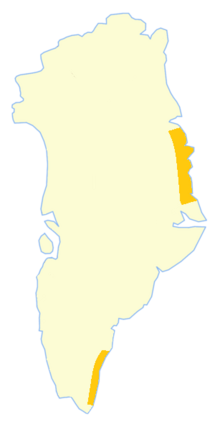|
Fridtjof Nansen Land
Fridtjof Nansen Land (Norwegian: Fridtjof Nansens Land) was a suggested but not officially adopted Norwegian name of a territory on the southern East Coast of Greenland,[1][2] that was proclaimed by Norway on July 12, 1932, and occupied until April 5, 1933. It was named after Norwegian polar explorer Fridtjof Nansen. The short-lived territory occupied much of King Frederick VI Coast, which had been claimed a century before by the Danish crown. The main settlements of the territory were Finnsbu in the north, with Trollbotn and Vogtsbu nearby, and Torgilsbu in the south. Fridtjof Nansen Land was also a proposed name of the archipelago Franz Josef Land, a territory to which Norway had claims.[3] References
Further reading
|
||||||||||||||||||||||||||||||||||||||||||||||||||||||||


